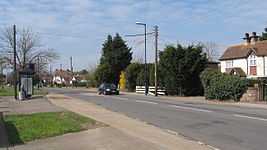Swalecliffe
| Swalecliffe | |
 View facing West on St. Johns Road in Swalecliffe |
|
 Swalecliffe | |
| District | City of Canterbury |
|---|---|
| Shire county | Kent |
| Region | South East |
| Country | England |
| Sovereign state | United Kingdom |
| Postcode district | CT5 2 |
| Dialling code | 01227 79**** |
| Police | Kent |
| Fire | Kent |
| Ambulance | South East Coast |
| EU Parliament | South East England |
| UK Parliament | Canterbury |
Swalecliffe is a village between Whitstable and Herne Bay and is opposite its neighbouring village Chestfield. The village has fewer than 400 residents, and is located in the South East of England.
In Swalecliffe, you can find:
- Chestfield & Swalecliffe railway station lies on the Chatham Main Line, which runs between Chestfield and Swalecliffe.
- ABC Pre Schools
- Village Hall
- Church Centre
- Village Post Office
- Local Estate Agents
- Local Architectural Specialist, Heritage Homes
- St. Augustines Business Development, Shaw Trust
- Village Church
- The Plough Inn and The Wheatsheaf
- Children's play area
- Large open field
- Direct pathway to the beach
- Swalecliffe and Chestfield Table Tennis Club
In 2005 Calmont purchased the land that used to be the village petrol station and garage "Quinneys Auto services" and converted it into a prosperous development named after the petrol station. The development features 16 houses and 4 apartments, 12 are semi-detached houses under the name of "Albany" and 4 terraced homes under the name of "Carlton", both of which are 3 bedroom houses. The apartments each have their own names; Bloomsbury, Belgravia, Chelsea and Mayfair. The private road on which the houses lie is called "Quinneys Place", some mapping tools and postcode finders still do not have this road indexed in their databases.
Swalecliffe School was recently in the media for pioneering a new lunch-time meal scheme, whereby pupils can help themselves to as much fruit and vegetables as they want. The new scheme has proven to be a great success with school dinner uptake growing to 40% of pupils.
-

An old groyne
-

Swalecliffe mudflats
-

Bright colours on the beach huts at Tankerton Bay catch the eye
-

Long Rock, a small shingly spit lies east end of Tankerton. On the skyline are some of the wind turbines in the Thames Estuary
Notes and references
External links
| Wikimedia Commons has media related to Swalecliffe. |
- Swalecliffe Community Primary School Website
- The Quinneys Development Site
- Swalecliffe Schools New Lunchtime Plan
- ABC Pre-Schools Swalecliffe
- Chestfield & Swalecliffe Station Assoc
